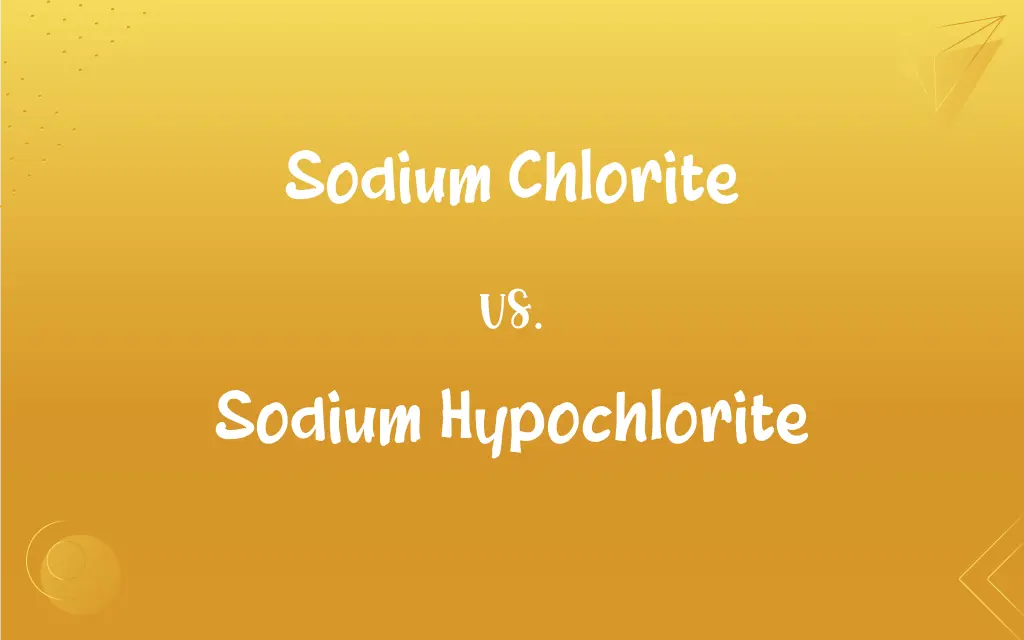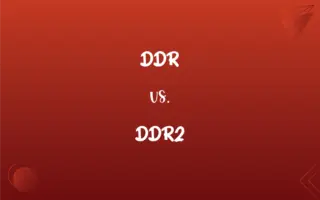Sodium Chlorite vs. Sodium Hypochlorite: What's the Difference?
By Janet White || Published on March 25, 2024
Sodium chlorite is mainly used as a precursor to chlorine dioxide, a disinfectant, while sodium hypochlorite is widely used as bleach and a disinfectant in water treatment.

Key Differences
Sodium chlorite (NaClO2) is often used in the production of chlorine dioxide, a powerful disinfectant, especially in water treatment and in making paper. Its role is crucial in industries requiring high levels of sterilization and for disinfecting drinking water. Sodium hypochlorite (NaClO), on the other hand, is commonly known as bleach. It is used both domestically and industrially for its bleaching and disinfecting properties, particularly in water purification, laundry, and surface cleaning.
Sodium chlorite is stable under normal conditions, it becomes a potent disinfectant when acidified to produce chlorine dioxide. This makes it highly effective but also requires careful handling to avoid generating toxic by-products. Sodium hypochlorite is recognized for its immediate action as a disinfectant and bleach, making it a go-to choice for routine cleaning and disinfection tasks. However, it can degrade in sunlight and reacts with organic material, potentially forming harmful compounds.
The use of sodium chlorite necessitates specific conditions to activate its disinfecting properties, typically involving acidification. This process needs to be carefully controlled to ensure safety and effectiveness. Sodium hypochlorite's disinfecting action is straightforward, requiring no activation, which simplifies its use in a wide range of applications from household cleaning to large-scale water treatment.
Safety precautions for handling sodium chlorite include measures to prevent its acidic activation in an uncontrolled manner, highlighting its potential hazards if not managed correctly. Sodium hypochlorite, while also requiring safe handling to avoid irritation or chemical burns, is generally considered less hazardous in common concentrations used for cleaning.
Despite their differences, both chemicals are valuable in public health for their disinfecting capabilities. Their use in water treatment underscores their importance in maintaining hygiene standards in public water supplies and in various industrial applications.
ADVERTISEMENT
Comparison Chart
Chemical Formula
NaClO2
NaClO
Primary Use
Precursor to chlorine dioxide; disinfectant
Bleaching, disinfecting
Activation Requirement
Yes, requires acidification
No, active as is
Stability
Stable, but reactive when acidified
Degrades in sunlight; reacts with organics
Safety Precautions
Careful handling to avoid toxic by-products
Avoid irritation, chemical burns; safer in common use
ADVERTISEMENT
Applications
Water treatment, sterilization
Water purification, laundry, cleaning
Sodium Chlorite and Sodium Hypochlorite Definitions
Sodium Chlorite
Requires careful handling due to its reactivity.
Proper storage of sodium chlorite is essential to prevent hazardous reactions.
Sodium Hypochlorite
Commonly known as household bleach.
Sodium hypochlorite is used to remove stains from laundry.
Sodium Chlorite
Activation through acidification is necessary.
To activate sodium chlorite's disinfecting power, it must be acidified.
Sodium Hypochlorite
Can degrade in sunlight and react with organics.
Store sodium hypochlorite in a dark place to prevent decomposition.
Sodium Chlorite
Effective in sterilizing drinking water.
Sodium chlorite, when converted to chlorine dioxide, purifies water efficiently.
Sodium Hypochlorite
Widely used for its immediate effectiveness.
Sodium hypochlorite is a popular choice for quick and effective disinfection.
Sodium Chlorite
Used in various industrial applications.
Industries use sodium chlorite for its powerful sterilization properties.
Sodium Hypochlorite
Used in water treatment facilities.
Municipal water systems use sodium hypochlorite for keeping water safe.
Sodium Chlorite
A chemical used for producing chlorine dioxide disinfectant.
Sodium chlorite is crucial in water disinfection processes.
Sodium Hypochlorite
Acts as a disinfectant without activation.
Sodium hypochlorite disinfects surfaces directly upon application.
FAQs
Why is sodium hypochlorite commonly used in households?
Its immediate action as a bleach and disinfectant, along with ease of use, makes it a popular choice for routine cleaning and laundry.
Can sodium chlorite and sodium hypochlorite be used interchangeably?
No, due to their different chemical properties and mechanisms of action, they serve different purposes and require different handling precautions.
What safety precautions should be taken when handling these chemicals?
Both chemicals should be handled with care, avoiding direct contact with skin and eyes, and ensuring proper ventilation. Sodium chlorite requires additional precautions to prevent uncontrolled acidification.
Why is sodium hypochlorite preferred for emergency water disinfection?
Its immediate action, availability, and ease of use make sodium hypochlorite a preferred choice for emergency water disinfection, effectively killing bacteria and viruses at low concentrations.
Is sodium chlorite safe for disinfecting drinking water?
Yes, when properly converted to chlorine dioxide, it is safe and effective for water disinfection.
How are sodium chlorite and sodium hypochlorite manufactured?
Both are produced through chemical processes involving the electrolysis of salt solutions, though the specific methods and reactants differ.
What is the main difference between sodium chlorite and sodium hypochlorite?
Sodium chlorite is used as a precursor to chlorine dioxide for disinfection, while sodium hypochlorite is directly used as bleach and a disinfectant.
Are there any health risks associated with sodium chlorite and sodium hypochlorite?
If not used according to safety guidelines, both can pose health risks, including chemical burns or the formation of harmful by-products.
What should be done in case of accidental exposure to these chemicals?
Rinse the affected area with plenty of water and seek medical advice. For inhalation, move to an area with fresh air and consult healthcare professionals.
How do sodium chlorite and sodium hypochlorite affect the environment?
Both can have environmental impacts, especially if discharged in large quantities or without proper treatment, potentially affecting aquatic life and water quality.
How do the disinfecting properties of sodium chlorite and sodium hypochlorite compare?
Sodium chlorite, once converted to chlorine dioxide, is a potent disinfectant that can kill a broad range of pathogens without forming harmful by-products at effective concentrations. Sodium hypochlorite is also a powerful disinfectant but may form chlorinated by-products in reaction with organic materials in water.
Can sodium chlorite be used for laundry bleaching like sodium hypochlorite?
Sodium chlorite is not typically used for laundry bleaching due to its need for acidification to become an effective bleaching agent and its potential to form toxic by-products if improperly handled.
What are the storage recommendations for sodium chlorite and sodium hypochlorite?
Both chemicals should be stored in cool, well-ventilated areas away from direct sunlight and incompatible substances. Sodium hypochlorite, in particular, should be stored in plastic containers to avoid decomposition and gas release.
How do the costs of sodium chlorite and sodium hypochlorite compare for water treatment?
The cost-effectiveness of using sodium chlorite or sodium hypochlorite for water treatment depends on the scale of application and specific treatment requirements. Sodium hypochlorite is generally less expensive and more readily available, making it a cost-effective choice for large-scale water treatment.
What are the by-products of sodium chlorite and sodium hypochlorite disinfection?
Sodium chlorite, when converted to chlorine dioxide, can produce minimal by-products under controlled conditions. Sodium hypochlorite can react with organic compounds in water to form trihalomethanes (THMs) and haloacetic acids (HAAs), which are potential health hazards.
How does pH affect the efficacy of sodium chlorite and sodium hypochlorite?
The efficacy of sodium chlorite as a disinfectant increases with acidity due to the generation of chlorine dioxide. Sodium hypochlorite's effectiveness as a disinfectant can decrease in alkaline conditions due to the formation of less active species.
What are the regulatory considerations for using sodium chlorite and sodium hypochlorite in water treatment?
Regulatory agencies set limits on the concentrations of chlorine dioxide and hypochlorite in drinking water to ensure safety and effectiveness while minimizing potential health risks from by-products.
Can these chemicals be used in swimming pools?
Sodium hypochlorite is commonly used for pool disinfection. Sodium chlorite is not typically used directly in pools but can be a source of chlorine dioxide for water treatment.
What industries primarily use sodium chlorite?
The paper manufacturing, water treatment, and food processing industries use sodium chlorite for its antimicrobial properties, especially in producing chlorine dioxide for bleaching and disinfection.
What should be considered when switching from sodium hypochlorite to sodium chlorite for disinfection purposes?
Switching requires careful consideration of the chemical handling and storage requirements, the need for acidification in the case of sodium chlorite, potential changes in disinfection by-product formation, and adherence to regulatory standards for water quality.
About Author
Written by
Janet WhiteJanet White has been an esteemed writer and blogger for Difference Wiki. Holding a Master's degree in Science and Medical Journalism from the prestigious Boston University, she has consistently demonstrated her expertise and passion for her field. When she's not immersed in her work, Janet relishes her time exercising, delving into a good book, and cherishing moments with friends and family.
































































